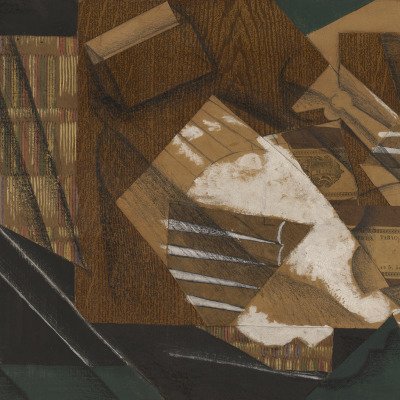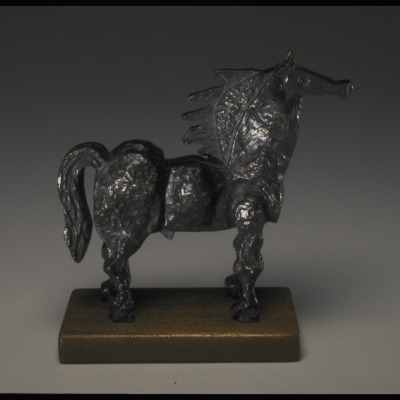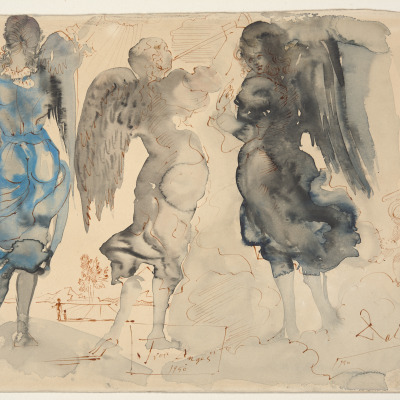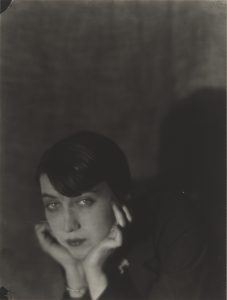
The Art of Man Ray’s Sitters
Explore works from VMFA's collection by many of the artists seen in Man Ray's portraits featured in the exhibition Man Ray: The Paris Years.
The Art of Man Ray’s Sitters
Introduction
VMFA’s exhibition Man Ray: The Paris Years focuses on the innovative portrait photographs that the American artist Man Ray made in the French capital between 1921 and 1940. In the early decades of the 20th century, Paris became famous the world over as a powerful center of artistic freedom and daring experimentation, which accounts for the extraordinary migration there of a large number of artists, architects, composers, dancers, fashion designers, filmmakers, musicians, and writers. Shortly after his arrival in July 1921, Man Ray embarked on a sustained campaign to document the international avant-garde in Paris between the two world wars in a series of remarkable portraits that established his reputation as one of the leading photographers of his era.
Explore works from VMFA’s collection by of many of the artists seen in Man Ray’s portraits!
Picasso
Internationally recognized as one of the most charismatic, innovative, and inventive artists of the 20th century, Pablo Picasso (1881–1973) transformed the history of art through his innate virtuosity and protean creativity. Man Ray made a number of portraits of the Spanish artist over the years.
Nude Athlete (Primary Title)
The Chinese Chest of Drawers (Primary Title)
The Banjo Player (Primary Title)
The Horse (Primary Title)
Pigeon on a Perch (Primary Title)
The Dove (Primary Title)
Paysage (Primary Title)
Woman with Kerchief (Primary Title)
Fish, Fruit Bowl, Bottle (Primary Title)
Toy Doll (Primary Title)
Jester on Horseback (Primary Title)
Le Viol from Suite Vollard (Primary Title)
Berenice Abbott
The American photographer Berenice Abbott (1898–1991) was born Bernice Abbott in Springfield, Ohio. After studying journalism at Ohio State University, she decided to become a sculptor and moved to Paris in March 1921. There, she adopted the French spelling of her name, Berenice, at the suggestion of Jean Cocteau. During her stay in Paris, Abbott shifted her focus from sculpture to photography, which she mastered while working as Man Ray’s darkroom assistant between 1923 and 1926.
Portrait of Edward Hopper (Primary Title)
New York Stock Exchange (Primary Title)
Princess Eugenie Murat (Primary Title)
Parabolic Mirror (Primary Title)
James Joyce (Primary Title)
Lyric Theatre, 3rd Avenue Between 12th and 13th Streets, Manhattan (Primary Title)
'El' Station 6th and 9th Avenue Lines Downtown Side: 72nd Street and Columbus Avenue, Manhattan
City Arabesque (Primary Title)
Bread Store, 259 Bleecker Street (Primary Title)
André Derain
In July 1905, the French artist André Derain (1880–1954) visited his former teacher Henri Matisse in the small French fishing village of Collioure, where they embarked on an extremely productive pictorial collaboration based upon their shared quest for pure liberated color. The resulting paintings, along with those of their mutual friend Maurice de Vlaminck, came to define the style known today as Fauvism.
The Port of Douarnenez (Translation)
Still Life with Flowers (Primary Title)
Landscape in Provence (Primary Title)
Marie Laurencin
The French painter, printmaker, and illustrator Marie Laurencin (1883–1956) was an important figure in the Parisian avant-garde and one of the best-known women artists of her generation. Although critics and art historians disparaged her work during her lifetime, relegating it to the margins of modernism, recent scholars have reclaimed the sexual politics and queer identity of Laurencin’s paintings and works on paper. Her artworks, which often focused on women from Greek mythology or ancient history such as Artemis, Diana, Salomé, and Sappho, connect Laurencin with the lesbian community in Paris, including the writer Nathalie Clifford Barney, the journalist Janet Flanner, and the photographer Berenice Abbott.
Carpet (Primary Title)
Férnand Leger
French Cubist painter Fernand Léger (1881-1955) was a revered modern master whose taut, geometric compositions of primary colors and abstract elements brought the energy and visual cacophony of the modern urban street into the realm of fine art.
Handkerchief (Primary Title)
Animated Landscape
Henri Matisse
The leader of the lively and innovative Fauve group, Henri Matisse (1869–1954) defined the cutting edge in art. The 1913 Armory Show, which helped pave the way for modern art in the United States, featured a generous selection of his works. Extolled for their originality by some critics and reviled for their extremism by others, they created quite a stir.
Lorette (Alternate Title)
[Untitled sketch of woman with violin] (Primary Title)
Tabac Royal (Primary Title)
Lorette (Alternate Title)
Letter containing sketch for 'Oranges' (Primary Title)
"Etude de Paysanne" (recto) and "Study of a Nude Figure" (verso) (Primary Title)
Two Views of the Same Woman (Primary Title)
Femme au Collier (Primary Title)
Lee Miller
Elizabeth “Lee” Miller (1907–1977) grew up in Poughkeepsie, New York, and moved to New York City in 1926 to study at the Art Students League. Her experience modeling for New York fashion photographers like George Hoyningen-Huené and Edward Steichen encouraged her to pursue her own career behind the camera. In May 1929, Miller moved to Paris and became Man Ray’s studio assistant after introducing herself in a nightclub. Miller played a crucial role in developing the Solarization technique with Man Ray after she accidentally exposed negatives in the darkroom to light.
Mr. and Mrs. Bukins Flat (Primary Title)
Juan Gris
Juan Gris was born in Spain but spent most of his short artistic career in France. He made his first Cubist paintings in 1911 and became one of Cubism’s greatest exponents. A logical and rigorous sense of composition defines his style.
Carafe, Glass, and Packet of Tobacco
Jug and Bottle (Primary Title)
Still Life (Translation)
Marcel Duchamp
Man Ray’s closest friend and 20th-century art’s greatest iconoclast, Marcel Duchamp (1887–1968) devoted his entire career to debunking pre-existing ideas about art, which he believed should appeal to the intellect rather than the senses. Man Ray met the French Duchamp in New York in 1915 and they began a lifelong friendship informed by a shared interest in humor, eroticism, chess, and the notion that the concept of a work of art was more important than its execution.
The Bride Stripped Bare by Her Bachelors, Even (The Green Box) (Translation)
Georges Braque
Along with his friend and colleague Pablo Picasso, the French artist Georges Braque (1882–1963) played a crucial role in the development of Cubism. The works produced during their intense artistic collaboration between 1907 and 1914 shattered preconceived notions about vision and asserted the flatness of the picture plane and the materiality of paint.
Still Life, Fruit (Primary Title)
Nature Morte (Primary Title)
The Pond from letters Amorosa by René Char (Primary Title)
Still Life (Primary Title)
Fruit Dish and Fruit Basket (Primary Title)
L'Oiseau devant la Lune (Primary Title)
The Yellow Bouquet (Primary Title)
Le Corbusier
The modern architect, painter, theorist, and urban planner Charles-Édouard Jeanneret (1887–1965) was one of the dominant forces in 20th-century architecture. He was born in La Chaux-de-Fonds, a small French-speaking town in Switzerland, and moved to Paris in 1917. Three years later, Jeanneret and the French painter Amédée Ozenfant launched Purism, an artistic movement based on simplified geometric forms and rational organization, which they promoted through their avant-garde periodical L’Esprit nouveau (The New Spirit). Beginning in 1920, Jeanneret adopted the pseudonym Le Corbusier (a slightly modified form of his maternal grandfather’s name, Lecorbésier) for his polemical essays, which were later published in his hugely influential 1923 book Vers une architecture (Toward an Architecture). Le Corbusier called for a rebirth of architecture based on function, modern technology, and pure form, as opposed to the excessive ornamentation of Art Deco.
Armchair (Primary Title)
Janet Scudder
The American expatriate sculptor Janet Scudder (1869–1940) was born Netta Deweze Frazee Scudder in Terre Haute, Indiana. She changed her name to Janet at age eighteen, after enrolling at the Cincinnati Art Academy. Scudder moved to Paris in 1894 and established her reputation as a master of graceful garden sculpture, which often featured charming cherubs, playful pipe-playing pans, and glistening water nymphs.
Little Lady of the Sea (Primary Title)
Maurice Vlaminck
A self-taught artist, Maurice de Vlaminck (1876–1958) was one of the key members of the movement known today as Fauvism. By 1905, when he exhibited his canvases alongside those of André Derain and Henri Matisse in the Salon d’Automne in Paris, Vlaminck’s work possessed the frenzied brushwork, heightened color, and expressive intensity that would become the hallmarks of the Fauve group’s contribution to modern art.
The Storm (Translation)
Sailing Boat, Chatou (Primary Title)
Maison dans les arbres (Primary Title)
Joan Miro
The whimsical abstract paintings that the Spanish Surrealist artist Joan Miró i Ferrà (1893–1983) made in Paris often registered his memories of the bucolic landscape of his homeland in northern Spain.
Black and Red (Translation)
Untitled from Nous Avons by René Char (Primary Title)
Yves Tanguy
French painter Yves Tanguy (1900–1955) moved to Paris following his compulsory military service in 1922. His Surrealist landscapes typically feature vast, arid plains and strange rock formations redolent of the prehistoric menhirs, dolmens, and other weathered boulders and standing stones he had encountered during his childhood in Brittany.
Askja (Primary Title)
Salvador Dali
Salvador Dalí (1904–1989), the best-known artist of the international Surrealist movement, transformed his dreams and personal obsessions into some of the most original and arresting images of the 20th century. Inspired by the psychoanalytical writings of Sigmund Freud, Dalí used his visionary paintings and nightmarish imagery to explore his sexual anxieties.























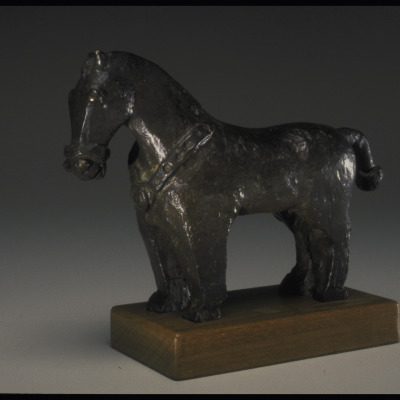




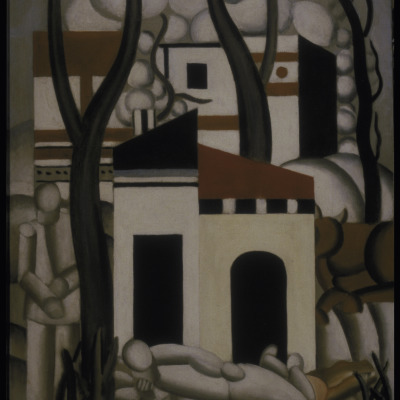

![[Untitled sketch of woman with violin] (Primary Title)](https://vmfa-dmz-new.piction.com/piction/ump.di?e=44A3400804BEF8484C781FF537670A9BBF3FABB0AED7C7EB61FEF4ACE1755183&s=21&se=619188206&v=1&f=xx47_10_75_v1_KW_200802_t.jpg#)







